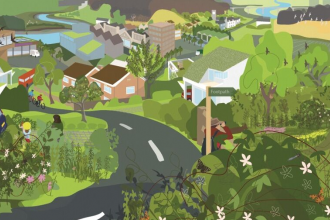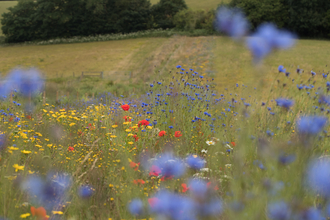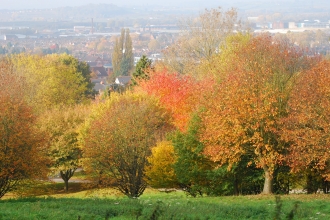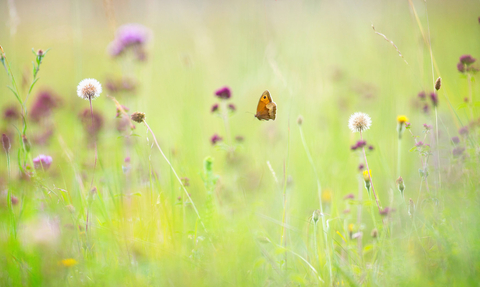
A butterfly in a thriving wildflower meadow. Photo by Jon Hawkins/Surrey Hills Photography
Biodiversity Net Gain and habitat banks
Article from Nature Matters in Berks, Bucks and Oxon, Autumn 2022
Dr Prue Addison, BBOWT's Conservation Strategy Director, considers Biodiversity Net Gain and reveals BBOWT's plans for habitat banks
An introduction to Biodiversity Net Gain
The former Truss Government and the levelling up secretary spoke about easing requirements for builders to leave land in a better state for the environment than beforehand. This would represent an undoing of one of the few positive changes to our planning system for the environment, known as biodiversity net gain (“BNG). At BBOWT, we have been working out how best to deliver BNG and how best to create “habitat banks” to create huge new spaces for nature.
Mandatory BNG for developments is due to come into effect in November 2023. The mitigation hierarchy must still be followed, and all developments should avoid harmful impacts on nature, but where planning permission is granted despite there being an impact on nature, every opportunity must be taken to maximise the creation of new habitats.
BNG can present a positive step forward, requiring all developments to address their environmental impacts, if it is implemented properly. At BBOWT, we want to show how BNG should be done to the highest standard to better help us influence its application and call out when it is done wrong. This is a new approach to development, and we believe that BNG can enable the creation or expansion of nature reserves and new places for wildlife, connecting existing habitats and can help to bring to life our Nature Recovery Network. We can’t allow the Government to destroy this opportunity in their pursuit of growth at all costs.
At the moment, BNG is not perfect, but it is a positive step forward. BNG will only help restore nature if it is delivered well – strong regulatory guidelines are essential. We are seeing examples where a voluntary approach is not enough to ensure good delivery. For BNG to have a positive impact, it needs to be managed and monitored effectively.
When development is done well it can include some really superb wildlife features on site, such as wildflower meadows, new trees and hedgerows, as well as homes for wildlife such as swift or bat boxes. But, of course, quite often habitats and wildlife are lost when development moves in and can’t be brought back on the development site. In such an instance, when such loss cannot be avoided, developers must be forced to properly compensate for the harm done and go further to help nature. This is where habitat banking plays its part.
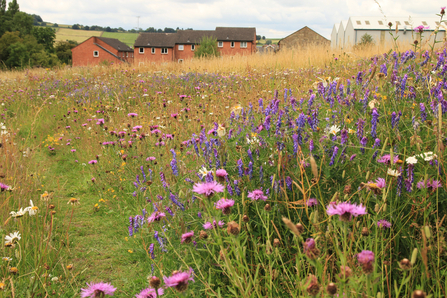
Developments done well can include good features for wildlife such as areas of wild flowers. Photo by Kieron Huston
A brief introduction to habitat banks
Habitat banks are sites that involve the creation of new, or enhancement of existing, habitats to compensate for habitats lost as a result of development. The biodiversity gained through habitat enhancements is measured in a standard way using the Defra biodiversity metric, which is the same metric that calculates the biodiversity loss from development.
Biodiversity units created on a habitat banking site are sold to developers to help them achieve a minimum increase of 10% BNG for their development. This is the first time there has been regulation to measure the loss of biodiversity from a development and to calculate an improvement and compensation beyond what has been lost. The metric is by no means perfect, so we are working hard to encourage developers, local authorities and the government to go further than the minimum requirement of 10%.
BBOWT have been working in partnership with three other Wildlife Trusts (Cheshire, Surrey and Warwickshire) and social enterprise financial advisors, Finance Earth, to pilot the development of three habitat banks in Oxfordshire, Warwickshire and Cheshire. This project has been funded by Defra’s Natural Environment Investment Readiness Fund and has helped us learn rapidly about how to create habitat banking sites.
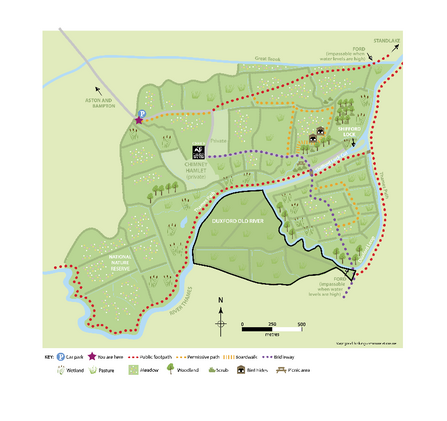
Duxford Old River is part of Chimney Meadows nature reserve, situated within the Upper Thames Living Landscape. Illustration by Corinne Welch/Good Thinking Communications.
Duxford Old River – BBOWT’s first habitat banking site
Guided by our Nature Recovery Network, we have selected our first habitat banking site in the Upper Thames Living Landscape. This landscape encompasses the floodplains of the upper Thames tributaries which make up one of the six best wetland areas in England.
Duxford Old River is BBOWT’s first habitat banking site which lies to the south of the Thames and is the most recently acquired parcel of land at Chimney Meadows nature reserve, which takes our landholding to an impressive 307 ha.
Prior to BBOWT securing the ownership of Duxford Old River, the site had been managed as commercial pasture for cattle, so had a very low value of biodiversity. Since acquiring the site, we used Water Environment Grant (WEG) funding to create a series of scrapes and water control structures to enable floodwater to be held back on site for longer into the spring. A large channel was also dug reconnecting the Thames around Shifford weir, facilitating fish passage into the upper reaches of the river.
Our habitat banking work builds on the WEG works, ensuring that the land at Duxford Old River becomes an ecologically functioning part of the floodplain. This 45 ha site will now be managed using a nature-led management approach, which will involve conservation grazing to drive the establishment of functioning ecological processes. Over the next 30 years we will enhance biodiversity through the creation of a mosaic of key floodplain habitats: wet woodland, meadow, scrub and wet grassland. These habitats will support species of wildfowl, waders, songbirds and specialist wetland invertebrates. This will create biodiversity units that can be sold to developers within the Vale of White Horse.
We are in negotiation with Trust for Oxfordshire’s Environment to sell an initial batch of units now. Before we agree to the sale of any units we ensure we undertake a thorough check of the developments seeking units from us, to make sure there are no unacceptable impacts on sites and habitats that have been identified as critical for nature, which includes our own nature reserves. Where a development has had an inacceptable impact on nature, we will not sell units to them.
We intend to sell some units from Duxford Old River over the coming years, and withhold some units to sell once we have measurable habitat improvements. This means developers will be sold units that reflect habitats that already exist, thus removing any delay in habitats lost from developments and gained on our site. We think this is critical to support rapid nature’s recovery.
BBOWT’s vision for Biodiversity Net Gain
Over the coming years we aim to implement up to 200 ha of habitat banking sites across Berkshire, Buckinghamshire, and Oxfordshire within our Nature Recovery Network. We aim to become a trusted delivery partner who will work with developers who want to go above and beyond BNG – as we will be selling units that represent BNG+ (biodiversity with multiple environmental and social benefits), and these will be on sites that will be managed in perpetuity, not just for 30 years.
We want to see BNG regulation implemented so that it supports nature’s recovery and is not just a compensation scheme for economic development where the environment and people lose out. If BNG standards are not raised and implementation is not enforced, BNG will not help us bring about nature’s recovery.
We are trying to improve the system and show how it should be done. And we certainly can’t do this on our own, so we are working in partnership with local planning authorities, environmental charities, financial advisors, land agents and ecological consultancies like our very own Future Nature, to help influence the best outcomes for BNG locally.
BNG has great potential to contribute to nature’s recovery. We cannot allow it to be undermined or done away with completely.
To find out more, please contact: publicaffairs@bbowt.org.uk

